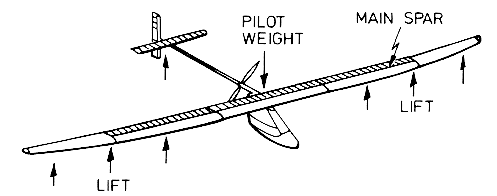| |
Humanpowered-Plane
Spars
The diagram shows two spar structures in a human-powered
plane. The tailplane is carried on a spar cantilevered from the cockpit
area, and the wing-spars define the wing structure. Both these components must
be resistant to bending and torsional deflection if the aerodynamic integrity
of the plane is to be preserved. The shape independent performance index
required is (E/r2), as minimizing bending is
the goal. Candidate materials are wood (spruce), aluminum alloy tubing, and
carbon fiber reinforced polymer (CFRP). The order represents the historic order
of material selection for these tasks. It is the ability to form shapes
that have attractive "shape factors" that make metals and CFRP the
more interesting candidates. Thin walled tubes can be formed from aluminum
alloys and the associated shape factor can be as high as 25 before buckling
during flight becomes a potential problem. This makes the material competitive
with wood! CFRP spars may also be formed into hollow sections and can have
shape factors of about 10. This value makes these sections better for spar
use than either solid spruce or aluminum tubes. |
|

